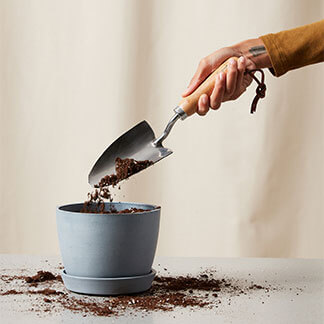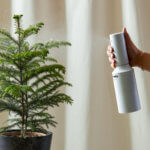How to care for your Scindapsus
Use these instructions to care for a Scindapsus. This guide will tell you how to water a Scindapsus; its light, temperature, humidity preferences and any additional care it might need to help it grow.
Silver Satin Pothos
Keep your Silver Satin Pothos in indirect bright light. Too little light will cause the silver color to fade, but too much light will burn the leaves.
These plants like to be mostly dry between waterings due to their thick leaves. Water when 75% of the soil volume is dry. Always water through and discard any excess water in the saucer to discourage root rot.
Your Silver Satin Pothos does well in average household humidity. However, if the air is very dry it will appreciate the occasional misting.
Silver Satin Pothos prefer average to warm temperatures of 65-85°F. Avoid cold drafty areas and open vents.
Feed monthly in the spring through fall with a general-purpose indoor plant fertilizer.
The SIlver Satin Pothos is toxic to humans and pets if ingested.
Trim out any dead, discolored, damaged, or diseased leaves and stems as they occur with clean, sharp scissors. Snip stems just above a leaf node; new growth will emerge from this cut and trimming close to the node will also prevent an ugly stub at the site. Use sharp pruning shears to avoid tearing the stems.
Scindapsus Jade Satin
Your Scindapsus prefers indirect bright light. This plant can only tolerate some direct sun in the morning; extended periods of direct light can burn the foliage.
Water your Scindapsus when the soil volume is 50-75% dry. Water thoroughly until water comes out of the drainage holes, and be sure to empty the saucer of any excess water. These plants are sensitive to overwatering—if the soil remains constantly wet, the roots will rot.
Average household humidity is fine for your Scindapsus, but higher humidity encourages larger leaves. Your plants will benefit from a pebble tray or adding a humidifier.
Your plant will grow well in temperatures between 65-80°F. Keep away from drafts, especially during the winter months.
Feed your Scindapsus monthly in the spring and summer with a general-purpose fertilizer. No fertilizer is needed in the fall and winter months when the plants are dormant. Always fertilize on moist soil, never dry, as it can burn the roots.
Scindapsus are toxic to humans and pets if ingested.
Scindapsus are easily propagated through cuttings to make new plants or help fill out the mother plants. Since these are climbers, you can add plant stakes or a moss pole to encourage larger leaf growth.
Scindapsus Moonlight
Your Scindapsus Moonlight prefers indirect bright light. This plant can only tolerate some direct sun in the morning; extended periods of direct light can burn the foliage.
Water your Scindapsus Moonlight when the soil volume is 50-75% dry. Water thoroughly until water comes out of the drainage holes, and be sure to empty the saucer of any excess water. This plant is sensitive to overwatering—if the soil remains constantly wet, the roots will rot.
Average household humidity is fine for your Scindapsus Moonlight but higher humidity encourages larger leaves. Your plant will benefit from a pebble tray or adding a humidifier.
Your Scindapsus Moonlight will grow well in temperatures between 65-85°F. Keep away from drafts, especially during the winter months.
Feed your Scindapsus Moonlight monthly in the spring and summer with a general-purpose fertilizer. No fertilizer is needed in the fall and winter months when the plant is dormant. Always fertilize on moist soil, never dry, as it can burn the roots.
This plant is toxic to pets and humans if ingested.
Trim out any dead, discolored, or damaged leaves using clean, sharp scissors. As the plant ages, the older leaves will naturally turn yellow or brown and fall off. This Scindapsus is easily propagated through cuttings to make new plants or help fill out the mother plant.

















